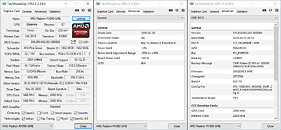Monday, March 9th 2020

AMD Radeon RX 590 GME is a Dressed Up RX 580: No more 12nm, Lower Performance
When AMD pushed out the Radeon RX 590 in late-2018, its key spec was that the "Polaris 20" die had been ported to GlobalFoundries 12LPP (12 nm) silicon fabrication node, yielding headroom to dial up clock speeds over the 14 nm RX 580. The underlying silicon was labeled "Polaris 30" as it was the second major version of the "Polaris 10" die. NVIDIA's GeForce GTX 16-series beat the RX 590 both in performance and price, with even the GTX 1650 Super performing on-par, and the GTX 1660 beating it. It turns out that AMD has a lot of unsold 14 nm "Polaris 20" inventory to go around, and it wants to release them out as the new RX 590 GME.
An Expreview review of an XFX-branded RX 590 GME confirms that the the chip is indeed based on the "Polaris 20 XTR" silicon which is built on the 14 nm process. The card has GPU clock speeds that appear similar to reference clock speeds of the RX 590, with 1460 MHz base compared to 1469 MHz of the original RX 590. But this is where the similarities end. In its testing, Expreview found that the RX 590 GME is on average 5% slower than the RX 590, and performs halfway between the RX 580 and the original RX 590, which are differentiated by a roughly 10% performance gap. The 5% performance deficit would put the RX 590 GME on par with the new RX 5500 XT 4 GB, and trading blows with the GTX 1650 Super. Thankfully, the RX 590 GME is priced lower than RX 590 cards (about 7.7% cheaper), and could be very region-specific. The fact that the RX 590 GME is being sold with full AIB partner branding and retail packaging, shows that this isn't an OEM-only product. Read the complete review in the source link below.
Source:
Expreview
An Expreview review of an XFX-branded RX 590 GME confirms that the the chip is indeed based on the "Polaris 20 XTR" silicon which is built on the 14 nm process. The card has GPU clock speeds that appear similar to reference clock speeds of the RX 590, with 1460 MHz base compared to 1469 MHz of the original RX 590. But this is where the similarities end. In its testing, Expreview found that the RX 590 GME is on average 5% slower than the RX 590, and performs halfway between the RX 580 and the original RX 590, which are differentiated by a roughly 10% performance gap. The 5% performance deficit would put the RX 590 GME on par with the new RX 5500 XT 4 GB, and trading blows with the GTX 1650 Super. Thankfully, the RX 590 GME is priced lower than RX 590 cards (about 7.7% cheaper), and could be very region-specific. The fact that the RX 590 GME is being sold with full AIB partner branding and retail packaging, shows that this isn't an OEM-only product. Read the complete review in the source link below.





36 Comments on AMD Radeon RX 590 GME is a Dressed Up RX 580: No more 12nm, Lower Performance
Tonga ships with only 28 CUs enabled, if it has more, they were used only in hidden cases (for instance for Apple orders, or something).
AMD gets the blame from videocardz :)videocardz.com/newz/amd-radeon-rx-590-gme-features-polaris-20-xtx
Here we go, guys. Enough said :)
285: 1792 / 112 / 32 - 28CU
290X: 2816 / 176 / 64 - 44CU
380: 1792 / 112 / 32 - 28CU
380X: 2048 / 128 / 32 - 32CU
Fury X: 4096 / 256 / 64 - 64 CU
470: 2048 / 128 / 32 - 32CU
480: 2304 / 144 / 32 - 36CU
Vega 10: 4096 / 256 / 64 - 64 CU
580: 2304 / 144 / 32 - 36 CU
Scorpio: 2560 / 160 / 32 - 40CU
Navi 10: 2560 / 160 / 64 - 40CU
Polaris was bump up in pipe design that nicely cut down to match the 380X. Bolt on upgrades get cut down.
Vega took the basic layout of the Fury, upgraded it and gave it much better FPU capabilities like the 290/390.
Scorpio is the One X GPU and it's based on the 290X and crushes Polaris under it's 384bit memory bus boot. Also suspiciously looks like Navi's layout... Well hey now you know why Navi is bandwidth limited with 256bit memory... LoL
Transistor numbers:
290X: 6,200 million
380X: 5,000 million
Fury X: 8,900 million
480: 5,700 million
Scorpio: 7,000 million
Vega 10: 12,500 million
Vega 20: 13,230 million
Navi 10: 10,300 million
In FP64 Perf
380X = 470 at around 300Gflops
Fury X = 590 at around 500Gflops
5700XT 50th AE sits around 600Gflops
390X = V64 LC at around 800Gflops
Vega 20 sits around 7,400 Gflops(commercial versions, consumer is 50%)
TSMC 7nm chip supply remains tight - Digitimes
TSMC Announces Major Expansion to Feed 7nm, 5nm Demand - ExtremeTech
CPU Shortages Might Be Set to Take a Toll on PC Industry Once Again - TheStreet
There you go. TSMC is actually expanding just to fill in demand so like I said 7nm is supply constrained. AMD has to continue producing 12 and 14nm chips as alternate sources of revenue, just as Intel actually cancelled EOL for some 22nm chips.
And I asked you for a proof that AMD sells every single chip they make, which of course can't be true.
Report: GPU, Motherboard Shipments Hitting Record Lows in Wake of Coronavirus Outbreak